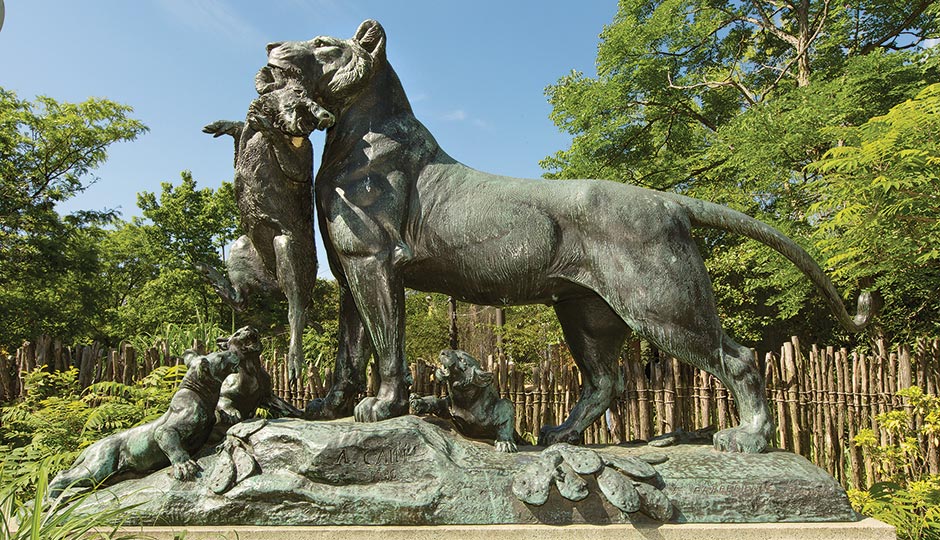11 Things You Might Not Know About: The Philadelphia Zoo
Who built the buildings? Where did the animals come from? Which iconic sculpture was moved because it spooked horses? And what the heck did Brigham Young have to do with all of it?

Photo | Mark Gavin, courtesy Temple University Press
Twenty years ago, Philadelphians awoke on Christmas Eve to dreadful news: A fire overnight in the World of Primates building at the Philadelphia Zoo had killed 23 animals, all of them members of endangered species. The tragedy made international headlines. Here, in memory of John, Snickers, Samantha, baby Maandazi and all the rest, are 11 things you might not know about the nation’s first zoo, courtesy (again) of James McClelland and Lynn Miller‘s new book, City in a Park.
- The original proponent of a zoo at Lemon Hill was Alfred Langdon Elwyn (1804-1884), a doctor, author and philanthropist who believed a zoological garden would contribute to the “oral and mental instruction of the citizens generally.” His 1840s proposal went nowhere, and he soon became distracted by his work as president of the SPCA and founder of a school for children with disabilities.
- A decade later, the cause was taken up by William Camac (1829-1900), another wealthy Philadelphian and a member of the Franklin Institute and the Academy of Natural Sciences. Camac had been impressed by zoos in Europe on his visits there, especially the London Zoological Society, so he solicited 36 fellow incorporators, and the Philadelphia Zoological Society was born on March 21, 1859.
- One of the co-founders, industrialist William Parker Foulke, had just excavated the first complete dinosaur fossil found in the United States (named Hadrosaurus foulkii in his honor) in Haddonfield, New Jersey. It became the first dinosaur skeleton in the world to be mounted for display, at the Academy of Natural Sciences. Today, a bronze replica stands outside the Reptile House in his honor.
- The Civil War temporarily suspended fund-raising efforts for the Zoo, but by March 1874, a total of $150,000 had been raised as a loan, to be repaid (with interest) to shareholders, who also got tickets to the Zoo. One funder, Quaker Alfred Cope, made it a condition of his $25,000 share that “all malt, vinous or spirituous liquors … be forever excluded from the premises.” This despite the fact his mother was a Drinker.
- The Fairmount Park Commission, which had rejected the proposal of famed landscape architects Frederick Law Olmsted and Calvert Vaux (they did New York’s Central Park) for their city park in favor of one by Hermann J. Schwarzmann, sent the young German immigrant to Europe to visit zoos there. Schwarzmann, who would soon serve as lead designer for the 1876 Centennial Exhibition, first laid out the Zoo, hiring many of the city’s leading architects to design buildings for it. Frank Furness created the gatehouses; his partner at the time, George Hewitt — together they designed the Pennsylvania Academy of the Fine Arts — created the Deer House, and the two collaborated on the Elephant House. (Today the Deer House is the George D. Widener Memorial Tree House.) Paul Cret designed the Pachyderm House in the style of a Pennsylvania Dutch barn; it’s now home to the Children’s Zoo.
- The Zoo stocked its cages by hiring renowned naturalist Frank J. Thompson to catch and transport live wild animals from overseas. It also accepted donations. Army General James S. Brisbin shipped bears, foxes, elk, wildcats, wolverines, eagles and deer from out West; Brigham Young sent two bears; the wife of General William Tecumseh Sherman donated Atlanta, the cow that had followed her husband on his march through Georgia. The first two lions arrived not long after the Zoo opened. Congress passed a bill waiving customs fees for all animals destined for the Zoo.
- On opening day — July 1, 1874 — 3,000 visitors arrived at the gates; when the new Girard Avenue Bridge opened three days later, there were 8,500 guests. Admission cost 25 cents for adults and 10 cents for children — prices that held steady for the next 50 years. Zoo memberships were $20 per year; a life membership cost a one-time payment of $50. Today, a one-year family membership is $135; an adult ticket is $20, discounted to $18 in winter.
- The 19th-century sculpture Mother Lioness Carrying to Her Young a Wild Boar by Auguste Nicholas Cain, acquired by the Fairmount Park Commission in the 1880s, was moved to the Zoo in the early 20th century from its original location on the River Drive because it kept spooking horses.
- Within one week in 1928, the Zoo saw the births of the first baby orangutan born in the U.S. and the first chimpanzee ever bred in captivity. The development in 1935 of the nutritious “zoocake” that fed many resident animals cut their death rate by more than half.
- On Christmas Eve in 1995, a fire in the World of Primates building killed 23 animals, including six lowland gorillas, three orangutans, four white-handed gibbons and 10 lemurs, all endangered species. The fire spurred the Zoo to create the Primate Reserve, which opened in 1999.
- The “Zoo360” system, which includes the elevated Big Cat Crossing and Gorilla Treeway as well as ground-based trails for giraffes, hippos and zebras, among other critters, was designed to create more roaming room in the Zoo’s 33 acres. Will such measures alleviate a growing public discomfort at viewing animals in confinement? Time will tell.
Follow @SandyHingston on Twitter.


